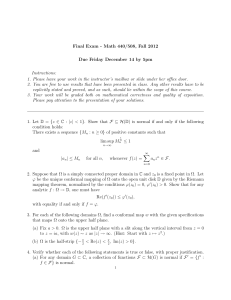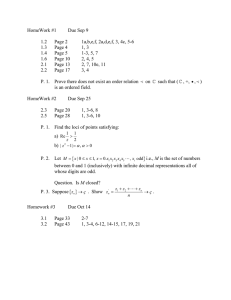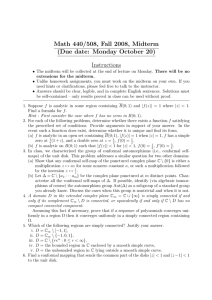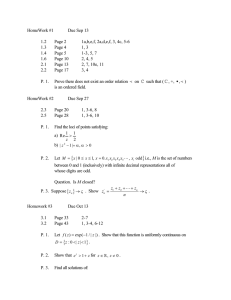Conformal blocks for the four-point function in conformal quantum mechanics Please share
advertisement
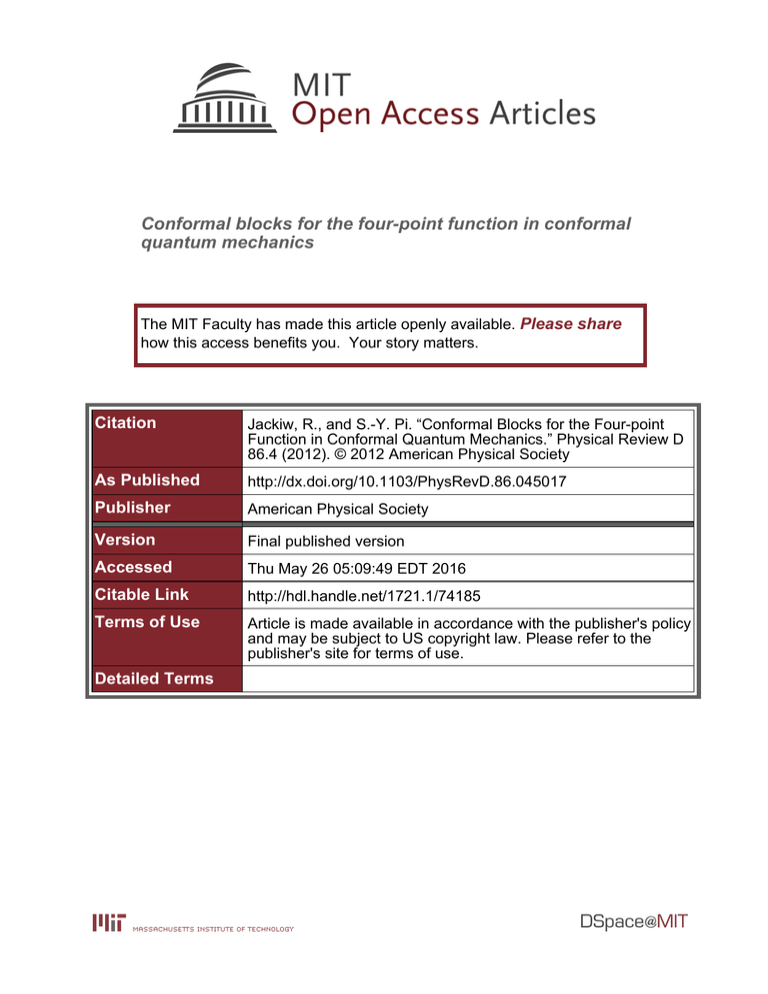
Conformal blocks for the four-point function in conformal quantum mechanics The MIT Faculty has made this article openly available. Please share how this access benefits you. Your story matters. Citation Jackiw, R., and S.-Y. Pi. “Conformal Blocks for the Four-point Function in Conformal Quantum Mechanics.” Physical Review D 86.4 (2012). © 2012 American Physical Society As Published http://dx.doi.org/10.1103/PhysRevD.86.045017 Publisher American Physical Society Version Final published version Accessed Thu May 26 05:09:49 EDT 2016 Citable Link http://hdl.handle.net/1721.1/74185 Terms of Use Article is made available in accordance with the publisher's policy and may be subject to US copyright law. Please refer to the publisher's site for terms of use. Detailed Terms PHYSICAL REVIEW D 86, 045017 (2012) Conformal blocks for the four-point function in conformal quantum mechanics R. Jackiw1 and S.-Y. Pi2 1 2 Department of Physics, MIT, Cambridge, Massachusetts 02139, USA Department of Physics, Boston University, Boston, Massachusetts 02215, USA (Received 7 May 2012; published 13 August 2012) Extending previous work on two- and three-point functions, we study the four-point function and its conformal block structure in conformal quantum mechanics CFT1 , which realizes the SOð2; 1Þ symmetry group. Conformal covariance is preserved even though the operators with which we work need not be primary and the states are not conformally invariant. We find that only one conformal block contributes to the four-point function. We describe some further properties of the states that we use and we construct dynamical evolution generated by the compact generator of SOð2; 1Þ. DOI: 10.1103/PhysRevD.86.045017 PACS numbers: 11.10.Kk I. INTRODUCTION AND REVIEW A recent paper [1] initiated research on the AdSdþ1 =CFTd correspondence for the special case d¼1. This dimension corresponds to the lowest ‘‘rung’’ on the dimensional ‘‘ladder’’ of SOðd þ 1; 1Þ conformally invariant scalar field theories in d dimensions. 1 Ld ¼ @ @ gð2d=d2Þ : 2 (1.1) At d ¼ 1 ½ðt; rÞ ! qðtÞÞ, L1 governs conformal quantum mechanics with a g=q2 potential [2], and supports an SOð2; 1Þ symmetry, with generators H, D and K. Their algebra i½D; H ¼ H; (1.2a) i½D; K ¼ K; (1.2b) i½K; H ¼ 2D; (1.2c) when presented in Cartan basis, 1 K R þ aH ; 2 a 1 K L aH iD; 2 a However, in CFT1 normalized states are not invariant and invariant states are not normalizable, rendering problematic calculation of expectation values. Furthermore, one wonders which operators in conformal quantum mechanics realize the primary operators ’ðtÞ, whose correlation functions arise from the AdS2 calculation. These puzzles are resolved in the paper [1]. We focus on the R operator, taken to be positive (g 0) and defined on the half-line (q 0), with integer-spaced eigenvalues rn and orthonormal eigenstates jni. Rjni ¼ rn jni; hnjn0 i ¼ nn0 ; ½L ; Lþ ¼ 2R: (1.3a) (1.6a) qffiffiffiffiffiffiffiffiffiffiffiffiffiffiffiffiffiffiffiffiffiffiffiffiffiffiffiffiffiffiffiffiffiffiffiffiffiffiffiffiffiffiffiffiffiffi L jni ¼ rn ðrn 1Þ r0 ðr0 1Þjn 1i: OðtÞ ¼ NðtÞ expð!ðtÞLþ Þ; !ðtÞ þ 1 2r0 NðtÞ ¼ ½ð2r0 Þð1=2Þ ; 2 a þ it ¼ ei where t ¼ a tan=2; !ðtÞ ¼ a it (1.3b) (1.4a) (1.4b) (1.7) and defined ‘‘t states’’ jti by the action of OðtÞ on the R vacuum. jti ¼ OðtÞjn ¼ 0i; (1.8) Rjn ¼ 0i ¼ r0 jn ¼ 0i: (1.9) From their definition (1.8) it follows that the jti states satisfy 1 (1.5) jti states that satisfy (by postulate) (1.10) were first presented by dAFF Ref [2]. Subsequently in Ref. [1] they were constructed by the action of the operator OðtÞ on the R vacuum, as in (1.7) and (1.8). 1 where ’ðtÞ are primary operators in the boundary conformal theory, and the averaging state h. . .i is conformally invariant, i.e. it is annihilated by the conformal generators. 1550-7998= 2012=86(4)=045017(5) n ¼ 0; 1. .. ; We need states that carry a representation of the SOð2; 1Þ action. To this end we constructed the operator OðtÞ, (a is a scaling parameter with dimension of time; frequently we set it to 1.) In spite of the natural position that d ¼ 1 enjoys, various questions arise about the correspondence. AdS2 calculations allegedly produce boundary N-point correlation functions in CFT1 . GN ðt1 ; . . . ; tN Þ h’1 ðt1 Þ . . . ’N ðtN Þi; r0 > 0; (1.6b) reads ½R; L ¼ L ; rn ¼ r0 þ n; 045017-1 Ó 2012 American Physical Society R. JACKIW AND S.-Y. PI d Hjti ¼ i jti; dt d Djti ¼ i t þ r0 jti; dt d Kjti ¼ i t2 þ 2r0 t jti: dt PHYSICAL REVIEW D 86, 045017 (2012) (1.10a) d ’ðtÞ; dt d i½D; ’ðtÞ ¼ t þ ’ðtÞ; dt d i½K; ’ðtÞ ¼ t2 þ 2t ’ðtÞ: dt (1.15) (1.10c) The two ’ fields are taken to be identical, with scale dimension . We demonstrate that conformal covariance and block structure are maintained by our unconventional realization of the conformal symmetry: once again defects cancel. In Sec. III, we study some further properties of the jti states and of related energy eigenstates jEi of the Hamiltonian H. Also we show how the R operator can replace H as the evolution generator. (1.11a) (1.11c) GN ðt1 ; t2 ; . . . ; tN1 ; tN Þ ¼ hn ¼ 0jOy ðt1 Þ’2 ðt2 Þ . . . ’N1 ðtN1 ÞOðtN Þjn ¼ 0i (1.12) In spite of the fact that the OðtÞ operators are not primary, and the averaging state jn ¼ 0i is not conformally invariant, the two ‘‘defects’’ cancel and the resultant N-point functions satisfy conformal covariance conditions. Consequently, in an operator-state correspondence we may consider the operators OðtÞ, when acting on the states jn ¼ 0i, as primary with dimension r0 . In this way one establishes that2 [3] G2 ðt1 ; t2 Þ ¼ ht1 jt2 i ¼ hn ¼ 0jOy ðt1 ÞOðt2 Þjn ¼ 0i ¼ ð2r0 Þa2r0 ; ½2iðt1 t2 Þ2r0 (1.13) G3 ðt1 ; t; t2 Þ ¼ ht1 j’ðtÞjt2 i ¼ hn ¼ 0jOy ðt1 Þ’ðtÞOðt2 Þjn ¼ 0i 2r þ i 0 ¼ hn ¼ 0j’ð0Þjn ¼ 0i 2 ð2r0 Þa2r0 : (1.14) ðt1 tÞ ðt t2 Þ ðt2 t1 Þ2r0 The expressions (1.13) and (1.14) also arise from calculations based on a scalar field in AdS2 , at the boundary of the AdS2 bulk. In Sec. II, we extend the investigation to the quantum mechanical four-point function. 2 dAFF Collaboration Ref. [2]. II. CORRELATION FUNCTION AND CONFORMAL BLOCK (1.11b) Thus an N-point function involves the jti states. ¼ ht1 j’2 ðt2 Þ . . . ’N1 ðtN1 ÞjtN i: ¼ hn ¼ 0jOy ðt1 Þ’ðt2 Þ’ðt3 ÞOðt4 Þjn ¼ 0i: (1.10b) N-point functions are constructed from the jti states. For GN ðt1 ; . . . ; tN Þ, the averaging state h. . .i is the R vacuum jn ¼ 0i. The first and last operators are taken to be Oy ðt1 Þ and OðtN Þ, while the remaining N 2 operators are conventional but unspecified primary operators ’, with scale dimension . i½H; ’ðtÞ ¼ G4 ðt1 ; t2 ; t3 ; t4 Þ ¼ ht1 j’ðt2 Þ’ðt3 Þjt4 i A. Four-point function in CFT1 To calculate G4 in (1.15), insert complete sets of jni states between the operators. Also without loss of generality evaluate the sums at special values: t1 ¼ ia, t4 ¼ ia. [This may always be achieved by a complex SOð2; 1Þ transformation.] One is left with a single sum. It remains to reduce matrix elements hnj’ðtÞjn0 i to hn ¼ 0j’ð0Þjn0 ¼ 0i. This was accomplished by dAFF [2] with the SOð2; 1Þ Wigner-Eckart theorem. This procedure leads to [4] G4 ðt1 ;t2 ;t3 ; t4 Þ ¼ jhn ¼ 0j’ð0Þjn ¼ 0ij2 1 X 2 ð1 Þ 2 ð2r0 Þ 22þ2r0 ðt13 t24 Þ2 ðt14 Þ2r0 2 1 xn ; 2 n¼0 ð2r0 þ nÞ ð1 nÞ n! t t tij ti tj ; x 12 34 : t13 t24 (2.1) (The scaling parameter a is set to unity.) Remarkably, the sum may be evaluated in terms of the hypergeometric function 2 F1 . The final expression for G4 is G4 ðt1 ; t2 ; t3 ; t4 Þ ¼ jhn ¼ 0j’ð0Þjn ¼ 0ij2 1 2þ2r0 2 ð2r0 Þ xr0 F ð; ; 2r0 ; xÞ: ðt13 t24 Þr0 ðt12 t34 Þþr0 2 1 (2.2) The polynomial in tij provides conformal covariance, while the x dependence is conformally invariant. (In one dimension four points lead to a single invariant, as opposed to two invariants in higher dimensions.) The four-point function may be presented by a Mellin transform since 2 F1 possesses a Mellin-Barnes representation. 045017-2 CONFORMAL BLOCKS FOR THE FOUR-POINT FUNCTION . . . 2 F1 ð; ; 2r0 ; xÞ ¼ ð2r0 Þ Z i1 2 ð þ sÞðsÞ ðxÞs : ds 2 ð2r0 þ sÞ ðÞ i1 (2.3) The sum in (2.1) arises from the poles of ðsÞ in (2.3). A single Mellin integral suffices at d ¼ 1 because there is only a single invariant. B. Conformal block in CFT1 In general one expects that the four-point function G4 may be presented as a superposition of ‘‘conformal blocks.’’ These quantities are kinematically determined by the eigenfunctions of the SOð2; 1Þ Casimir. This is like a partial wave expansion of a scattering amplitude—indeed ‘‘conformal partial waves’’ is an alternative nomenclature. Conformal blocks at arbitrary d for SOðd þ 1; 1Þ have been extensively studied by Dolan and Osborn. Recently they have constructed the d ¼ 1, SOð2; 1Þ quantities by passing to the (somewhat singular) limit d ! 1 for a block coming from a single operator and its descendants [5]. In contrast, from the start we work directly with the SOð2; 1Þ symmetry at d ¼ 1. We present the general four-point function. PHYSICAL REVIEW D 86, 045017 (2012) H ¼ H1 þ H2 ; K ¼ K1 þ K2 ; D ¼ D1 þ D2 @ @ @ Hi ¼ i ; Di ¼ i ti þ i ; Ki ¼ i t2i þ 2i ti : @ti @ti @ti (2.8) c is the eigenvalue. Thus the derivative operator D corresponding to C, @2 @ @ D t212 þ 2t12 2 1 @t1 @t2 @t1 @t2 þ ð1 þ 2 Þ2 ð1 þ 2 Þ; acts on pB as DðpBÞ ¼ pðx2 ð1 xÞB00 þ ð1 þ 12 34 Þx2 B0 þ 12 34 xBÞ ¼ 1 þ2 ðt12 Þ 3 þ4 ðt34 Þ 1 FðxÞ ðt13 Þ34 ðt14 Þ12 34 ðt24 Þ12 ¼ pðt1 ; t2 ; t3 ; t4 ÞFðxÞ: x2 ð1 xÞB00 þ ð1 þ 12 34 Þx2 B0 þ 12 34 xB ¼ cB; (2.11) and is solved by B ¼ x 2 F1 ð 12 ; þ 34 ; 2; xÞ; c ¼ ð 1Þ: (2.12a) (2.12b) In order to match this block to the four-point function (2.2) where 1 ¼ 4 ¼ r0 , 2 ¼ 3 ¼ we must set ¼ r0 , so that B ¼ xr0 2 F1 ð; ; 2r0 ; xÞ: (2.4) The t-polynomial p carries the conformal transformation property of G4 , while F is invariant. i is the dimension of ’i and ij i j . (This expression is more general than the one we used in our previous discussion, which is specialized to 1 ¼ 4 ¼ r0 , 2 ¼ 3 ¼ , ’1 ¼ Oy , ’4 ¼ O, ’2;3 ¼ ’.) The block decomposition states X (2.5) FðxÞ ¼ bi Bi ðxÞ; (2.10) d ). The eigenvalue equation reads (dash signifies dx G4 ðt1 ; t2 ; t3 ; t4 Þ ¼ h’1 ðt1 Þ’2 ðt2 Þ’3 ðt3 Þ’4 ðt4 Þi (2.9) (2.13) Evidently the single block (2.13) reproduces the four-point function. It is a surprise that one block suffices. The usual route to conformal blocks is through the shortdistance expansion for ’1 ðt1 Þ’2 ðt2 Þ. In our construction ’1 ðt1 Þ is replaced by Oy ðt1 Þ, which does not have an evident short distance expansion with ’2 ðt2 Þ. Nevertheless, within our approach we are able to derive a block representation for the four-point function. This puts into evidence once again that our method, with its cancellation of defects, preserves conformal covariance. i where i labels the kinematical variety of blocks Bi . Each Bi is constructed from a specific primary operator and its descendants. The bi ’s contain dynamical data. The blocks are eigenfunctions of the Casimir. 1 C ¼ ðHK þ KHÞ D2 ; 2 CðpBÞ ¼ cðpBÞ: (2.6) III. VARIOUS OBSERVATIONS ON THE FORMALISM The construction of the states jti in (1.7) and (1.8) has found response in the literature [6]. Therefore, we elaborate some of their further properties, which follow from (1.2) and (1.10). A. Energy eigenstates (2.7) Since the action of H on jti is known from (1.10a), it is readily seen that3 In (2.6) and (2.7), the individual generators are sums of the corresponding derivative operators 045017-3 3 Energy eigenstates were defined by dAFF, Ref. [2]. R. JACKIW AND S.-Y. PI jEi ¼ 2r0 PHYSICAL REVIEW D 86, 045017 (2012) E1=2 Z 1 dt iEt e jti ðaEÞr0 1 2 (3.1) Then (3.7) and (3.8) show that 1 1=2 ð2r0 Þjn ¼ 0i; 22r0 1 jt ¼ 0i ¼ 2r0 1=2 ð2r0 ÞeHa jn ¼ 0i: 2 eHa jt ¼ 0i ¼ is an orthonormal energy eigenstate. The prefactor ensures normalization. hEjE0 i ¼ ðE E0 Þ: (3.2) The SOð2; 1Þ generators act as HjEi ¼ EjEi; d 1 þ jEi; DjEi ¼ i E dE 2 d2 d ðr0 1=2Þ2 þ jEi: KjEi ¼ E 2 dE E dE ðaEÞr0 iEt e : E1=2 (3.4) B. (In)completeness of the jti states Combining (3.1) with (3.4) gives E Z 1 dt jtihtjEi; jEi ¼ 22r0 ðaEÞ2r0 1 2 jti ¼ eiHt jt ¼ 0i ¼ (3.5a) 1=2 ð2r0 Þ ðaþitÞH e jn ¼ 0i: 22r0 (3.9b) This is an interesting alternative to (1.7) and (1.8). (3.3c) The jEi states allow establishing further properties of the jti states, whose overlap with jEi is determined from (1.13) and (3.1). htjEi ¼ 2r0 Since H generates t evolution, a further consequence is4 (3.3a) (3.3b) (3.9a) D. Alternative evolution In our treatment evolution takes place in t time and is generated by H. This is seen in (1.10a) and (1.11a), where the action of H is time derivation, i.e. infinitesimal time translation. However, our formalism is based on R, rather than H. Thus recasting evolution so that it is generated by R becomes an interesting alternative. This is accomplished by redefining time t. Observe from (1.10) that 1 K 1 d rt Rjti ¼ aH þ jti ¼ i ½a þ t2 =a þ 0 jti: 2 a 2 dt a (3.10) Upon defining a new ‘‘time’’ , or 22r0 Z 1 dt ðaHÞ2r0 jtihtjEi: jEi ¼ H 1 2 Since the energy eigenstates are complete, we arrive at an (in)complete relation for the jti states. 1 aH 2r0 Z 1 dt jtihtj: (3.6) ¼ H 2 1 2 ðcos=2Þ2r0 d ððcos=2Þ2r0 jt ¼ a tan=2iÞ: d Hence if we define new time states ji (3.12) it follows that R translates infinitesimally. In the paper [1] it is shown that Rji ¼ i (3.7) satisfies Rj c i¼r0 j c i; hence j c i is proportional to jn¼0i. Naming the proportionality constant N , we have ~ expðei Lþ Þjn ¼ 0i; ji ¼ NðÞ ~ NðÞ ¼ ðcos=2Þ2r0 Nðt ¼ a tan=2Þ; (3.8a) ¼ ½ð2r0 Þ1=2 eir0 : 0 The matrix element (with a restored) is given by (3.4). Therefore Z1 1 aE 2r0 ð2r0 Þ jN j2 ¼ dEe2Ea ¼ 2r0 : (3.8b) E 2 4 0 d ji: d (3.13) Explicitly the state ji is given by j c i ¼ N jn ¼ 0i; jN j2 ¼ h c j c i ¼ ht ¼ 0je2Ha jt ¼ 0i; Z1 ¼ dEe2Ea jht ¼ 0jEij2 : (3.11) [compare (1.7)] the expression in the last parenthesis of (3.10) may be rewritten as ji ¼ ðcos=2Þ2r0 jt ¼ a tan=2i; C. State-operator correspondence j c i eHa jt ¼ 0i t ¼ a tan=2 (3.5b) (3.14a) (3.14b) The spectrum of H is continuous and the conjugate time variable is unrestricted. On the other hand, the spectrum of R is discrete, equally spaced, and the conjugate variable is periodic. 045017-4 4 Nakayama, Ref [6]. CONFORMAL BLOCKS FOR THE FOUR-POINT FUNCTION . . . In terms of the new variable, the two-point function becomes (see footnote 4) G2 ð0 ; Þ ¼ ð2r0 Þ : 0 2r0 ½2ifsin½ 2 g (3.15) One may also consider evolution generated by 12 ðaH KaÞ. This development begins when the new time is defined as t ¼ a tanh=2, which leads to similar replacement in (3.11), (3.12), (3.13), (3.14), and (3.15) of trigonometric functions by hyperbolic ones. PHYSICAL REVIEW D 86, 045017 (2012) are not invariant [R vacuum jn ¼ 0i]. Nevertheless results obey the conformal constraints. For the two- and three-point functions an AdS2 bulk dual can be identified [1]. We have not accomplished that for the four-point function. But the simplicity of the block structure—just one block is needed to reproduce the fourpoint function—gives the hope that a dual model in the AdS2 bulk can be found. It is interesting to observe that the AdS2 bulk propagator is given by a hypergeometric function, just as G4 and its conformal block are. ACKNOWLEDGMENTS IV. CONCLUSION We have studied the four-point function and its conformal block for CFT1 conformal quantum mechanics. We used operators that are not primary ½OðtÞ and states that We acknowledge conversations with S. Behbahani, C. Chamon, D. Harlow and L. Santos. This research is supported by the DOE under Grant Nos. DE-FG0205ER41360 (R. J.) and DE-FG02- 91ER40676 (S. Y. P). [1] C. Chamon, R. Jackiw, S.-Y. Pi, and L. Santos, Phys. Lett. B 701, 503 (2011). Corrections: Eq. (2.9), first line, add ‘‘R.’’ Eq. (3.15), replace second equals sign by proportionality sign. [2] Scale-free quantum mechanics was investigated in response to MIT/SLAC deep inelastic scattering results. The g=q2 potential appeared in a pedagogical article on scale symmetry: R. Jackiw, Phys. Today 25, No. 1, 23 (1972).The model was thoroughly investigated by V. de Alfaro, S. Fubini, and G. Furlan (dAFF Collaboration), Nuovo Cimento Soc. Ital. Fis. A 34, 569 (1976). [3] A careful evaluation shows that the singularity in G2 ðt1 ; t2 Þ at, t1 ¼ t2 is regulated as t1 t2 ! t1 t2 i". [4] S. Behbahani and D. Harlow (unpublished). Eq. (2.1) was communicated to us by S. Behbahani. Some small but crucial sign errors needed correcting. [5] F. Dolan and H. Osborn, arXiv:1108.6194. [6] R. Nakayama, Prog. Theor. Phys. 127, 393 (2012); B. Freivogel, J. McGreevy, and S. J. Suh, Phys. Rev. D 85, 105002 (2012); D. Anninos, S. A. Hartnoll, and D. M. Hofman, Classical Quantum Gravity 29, 075002 (2012). 045017-5
